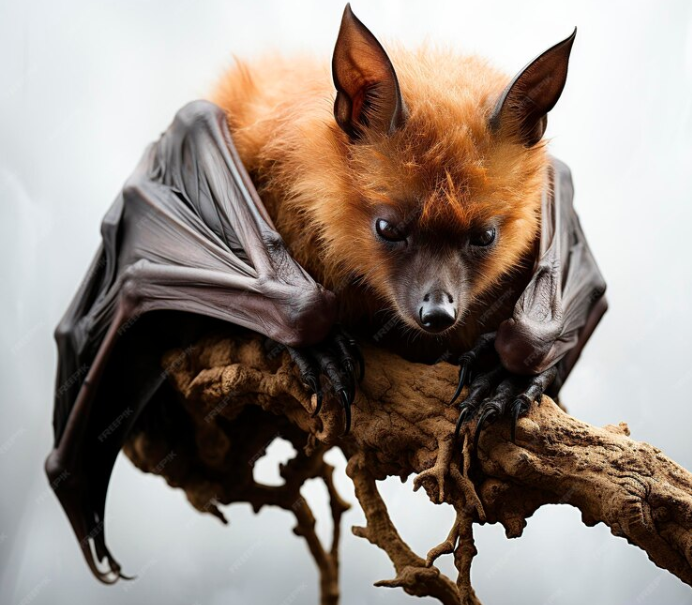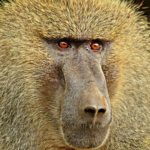Bats are unique mammals known for being the only species capable of true flight. Found on every continent except Antarctica, bats play a crucial role in nature by pollinating plants, spreading seeds, and controlling pests. Using echolocation to navigate the night, bats are essential to healthy ecosystems and are far more beneficial than many people realize.
Quick Top 10 Facts about Bat
| SCIENTIFIC NAME | Chiroptera |
| CLASSIFICATION | KINGDOM: Animalia PHYLUM: Chordata CLASS: Mammalia ORDER: Chiroptera |
| SIZE | Varies widely by species; wingspan: 5.7 in (14.5 cm) to 5.6 ft (1.7 m); weight: 0.07 oz to 3.5 lbs (2 g to 1.6 kg) |
| HABITAT | Worldwide except extreme deserts and polar regions; roost in caves, trees, buildings, and crevices |
| DIET | Insectivorous, frugivorous, nectarivorous, carnivorous, and some species feed on blood (vampire bats) |
| SPECIES | Over 1,400 species globally, ranging from tiny bumblebee bats to large flying foxes |
| COUNTRY | Found on every continent except Antarctica |
| GESTATION PERIOD | Varies by species, generally 40–180 days |
| LIFE SPAN | 5–30 years, depending on the species |
| CONSERVATION STATUS | Many species are of Least Concern, but others are threatened or endangered due to habitat loss and disease |
Amazing Facts About Bats
1. Bats are the only flying mammals
Unlike flying squirrels that glide, bats can truly fly with wings formed by a membrane stretched across elongated fingers.
2. Some use echolocation to hunt
Many bats navigate and find prey using echolocation—emitting high-pitched sounds and interpreting the returning echoes.
3. They’re vital pollinators
Fruit and nectar-eating bats pollinate plants like bananas, mangoes, and agave (used to make tequila!).
4. They consume tons of insects
A single little brown bat can eat over 1,000 mosquitoes in one hour, helping control pest populations.
5. Not all bats drink blood
Only three species of vampire bats feed on blood, and they typically target livestock, not humans.
6. Some bats live in massive colonies
Bat colonies can number in the millions, especially in caves—like the famous Bracken Cave in Texas.
7. Bats hang upside down to rest
They roost upside down to protect themselves from predators and take off quickly when needed.
8. They have long lifespans
Bats are small mammals but can live decades—some species live over 30 years in the wild.
9. White-nose syndrome is a major threat
This fungal disease has devastated North American bat populations, especially during hibernation.
10. Bats are important to ecosystems
Bats help with pollination, seed dispersal, and insect control, making them crucial to many environments.
Important Facts about bats in the animal kingdom
Bats are amazing animals with distinctive qualities. Because of their wings, which are made of a thin membrane stretched between elongated fingers, they are the only animals that can fly for extended periods of time. Additionally, well-known for their remarkable echolocation skills, bats use sound waves to travel and find prey in the dark. There are more than 20 million bats in the largest single-bat colony. More facts about bats are:
Overview of facts about bats as a species and unique hunting nature
Bats are among the most varied families of animals, with over 1,400 species found worldwide. They live in a variety of settings, including cities and deserts as well as woodlands. As pollinators and seed dispersers, bats are essential to the health and variety of plant life in ecosystems. With an estimated 20.6 million Mexican free-tailed bats, Bracken Cave in Texas is home to the biggest single-bat colony in the world. This figure is startling and represents around one-third of the bat species’ global population.
Bats are not blind, unlike what many people think. Although they depend mainly on echolocation for hunting and navigation, they have highly excellent vision. Bats help manage bug populations by eating a lot of mosquitoes and agricultural pests. They are typically safe for people to be around. Despite their significance, bats are threatened by a number of factors, including illness and habitat degradation; thus, conservation efforts are essential to their existence.
Fascinating facts about bats and their unique behaviours
For generations, people have been captivated by the intriguing nature of bats. Owing to their unusual ability to fly and their nocturnal lifestyle, bats are now the focus of several myths and misunderstandings.
1. Adaptability and Diversity
The order Chiroptera, which includes two suborders—the Megachiroptera, which includes huge fruit bats, and the Microchiroptera, which includes little insect-eating bats—is where bats are classified. Bats are among the most varied families of animals, with over 1,400 species.
Around the globe, bats have evolved to live in a variety of environments, including deserts, jungles, and even cities. Every continent, with the exception of Antarctica, is home to them.
2. Specialized Flight Skills
The only animals that can fly continuously are bats. A thin skin membrane, stretched between expanded fingers, makes up their wings. They can move quite quickly in the air because of this adaptation.
Bats are not blind, unlike what many people think. While some animals use echolocation to find their food, most species have good eyesight. Bats have an amazing talent called echolocation, which involves them making high-frequency noises and using the echoes to map out their environment in their minds.
3. Significance of Ecological
Globally, bats are essential to ecosystems. Numerous species hunt and devour large quantities of moths, mosquitoes, and agricultural pests. Insect population regulation and the requirement for chemical pesticides are both aided by this natural pest management method.
Certain bats are also significant pollinators. They help many different plant species reproduce by feeding on nectar and unintentionally spreading pollen from blossom to flower, including commercially significant ones like agave (which is used to manufacture tequila) and bananas.
4. Lifespan and Reproduction
When compared to other animals of comparable size, bats have rather lengthy lives. In the wild, some species may survive for up to 30 years or more.
The majority of bats reproduce slowly; females usually give birth to only one youngster per year. Different species have different gestation times, which may be anything from a few weeks to several months. Puppies, or young bats, are dependent on their mothers for protection and sustenance since they are born in a very immature form.
5. Threats and Preservation efforts for bats
Bats are important to the ecosystem, yet they are threatened by a number of factors, such as illness, habitat loss, and climate change.
White-nose syndrome (WNS), a fungal illness that has wiped out bat populations in North America, is one of the biggest risks to bats. Bats who have WNS wake up from hibernation too often, which may result in malnutrition and death.
To preserve bat populations and their habitats, conservation initiatives are being carried out. These include installing bat homes to provide other roosting locations, creating protected areas, and educating people about conservation.

A comprehensive collection of information and facts about bats
1: Mammals
Bats are classified as mammals and are the only members of the Chiroptera order of animals that can fly continuously.
2: Variety of Species
After rodents, bats are the second most varied order of mammals, with over 1,400 species. With 25% of all species, bats are the second-biggest group of mammals in terms of species diversity. They are thus considerably more varied than rodents, which make up around 21%.
3: Bats have special wings
Bats’ wings are made up of extended fingers that are coated in a thin layer of skin. The only species of mammal capable of actually flying is the bat. They can fly continuously, unlike other animals, such as flying squirrels, which only glide in the air, despite giving the impression that they are flying. Bats move through the air with the help of their strong muscles and wings.
4: Echolocation
To find their way around and locate prey, many bats use echolocation. They make high-frequency noises, and they can identify items in their surroundings by listening for the echoes that return.

5: Diet and food habit
Bats consume a wide variety of foods, including fruit, nectar, fish, insects, and even blood. Since most bat species are insectivores, they aid in the management of insect populations.
6: Nocturnal Behavior
The majority of bats are nocturnal, which means they are active at night. Certain species, on the other hand, are diurnal (active throughout the day) or crepuscular (active at dawn and dusk).
7: Social Behavior
Bats have a wide range of roosting locations, including caverns, trees, buildings, and subterranean constructions. While some species prefer to roost alone, others develop sizable colonies.
8: Longevity
In comparison to other animals of comparable size, bats may have comparatively lengthy lives. Certain creatures have life spans exceeding thirty years.
9: Production of Guano
Bat guano, or excrement, is an excellent natural fertiliser. It has been collected for agricultural purposes in certain areas.
10: Pollination support
Bats are essential to the processes of pollination and seed dissemination. In particular, fruit bats are crucial to the upkeep of ecosystems and the dispersal of seeds for plant reproduction.
11: Hibernation
Some species of bats in colder climates hibernate over the winter to save energy when insects, their main food source, are in short supply.
12: Threats and Conservation
White-nose syndrome, pesticide usage, and habitat loss are just a few of the ailments that bats have to deal with. In order to preserve bat populations and the ecological roles they play, conservation initiatives are essential.
13: Flying Foxes
Among the biggest bat species are the megabats, sometimes referred to as flying foxes. They have big eyes and features that resemble foxes, and they may be found in tropical and subtropical areas.
14: Rabies
Although they are often linked to the disease, not all bats are carriers of the virus. On the other hand, care should be taken and wild-bat interaction should be avoided.
15: Insect Population Control
One of the few naturally occurring predators of mosquitoes and other flying insects is the bat. Furthermore, bats play a significant role in the pollination of several plants and the seed dispersal of numerous tree species.
16: Highly advanced sonar
Bats use a technique known as echolocation to find their way around at night. They release ultrasonic sound waves, which return to the bat after bouncing off nearby objects. Bats can precisely determine distance and the size, shape, and texture of things in their environment by deciphering these sound waves.
17: Not Every Bat Intakes Blood
While vampire bats get a lot of attention, the majority of bat species just eat insects. There are just three species of bats that feed on blood, and they are found in South and Central America.

FAQ (Frequently Asked Questions) about Bats
Q: What is a Bat?
Ans: A bat is a flying mammal known for its unique ability to fly. Bats are the only mammals capable of sustained flight. They belong to the order Chiroptera and are found worldwide, except in extremely cold regions.
Q: How do bats fly?
Ans: Bats have elongated fingers and a flexible membrane of skin between them, which forms wings. This wing structure allows them to fly efficiently and maneuver in the air with precision. Bats are agile fliers and are well adapted for navigating through dark environments.
Q: What do bats eat?
Ans: Bats have diverse diets depending on the species. Most bats are insectivorous, feeding on insects like moths, beetles, and mosquitoes. Some bats are frugivorous (fruit-eating), while others are nectarivorous (nectar-feeding) or even carnivorous, feeding on small animals like fish, frogs, and other vertebrates. A small group of bats are also known to consume blood (vampire bats).
Q: Where do bats live?
Ans: Bats are found in a wide range of habitats, from caves and hollow trees to attics and artificial structures. They often roost in dark, sheltered areas during the day, emerging at night to feed. Some species are migratory, while others are more sedentary, depending on their environment and food availability.
Q: Are bats dangerous to humans?
Ans: While bats are not dangerous to humans in most cases, they can carry diseases like rabies, which can be transmitted through bites or scratches. However, the risk of getting rabies from a bat is extremely low. It’s important to avoid handling bats, especially if they are sick or injured.
Q: Why are bats important for the environment?
Ans: Bats play a crucial role in ecosystems. They help control insect populations by consuming vast numbers of insects, including mosquitoes and agricultural pests. They also pollinate plants and disperse seeds, which is important for the regeneration of forests and the production of certain fruits.
Q: How long do bats live?
Ans: Bats can have varying lifespans depending on the species, with some living up to 20 or more years. Some small species live for only a few years, while larger species may live longer. Bats have high survival rates when young, but many face threats from habitat loss and human activity.
Q: How do bats navigate in the dark?
Ans: Bats use a technique called echolocation to navigate in the dark. By emitting high-pitched sounds that bounce off objects in their environment, bats can determine the location, size, and shape of objects around them. This allows them to fly in complete darkness, hunting for insects and avoiding obstacles.
Q: Do bats hibernate?
Ans: Some species of bats hibernate during the colder months when food is scarce. They enter a state of torpor, where their metabolism slows down significantly to conserve energy. This behavior is common in species found in temperate regions.
Q: Can bats be kept as pets?
Ans: Bats are wild animals and are not suitable to be kept as pets. They play an important role in nature and should be appreciated from a distance. It is illegal in many places to capture or keep bats without a proper permit.
#Bats, #Echolocation, #FlyingMammals, #WildlifeConservation, #Insectivorous, #BatFacts, #Pollinators, #Nightlife, #WildlifeProtection, #Biodiversity
Our sources and references about Bats
1: Wikipedia – Bat
2: Bat Conservation International
3: National Geographic – Bat Facts
4: Audubon – Bats


